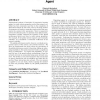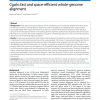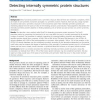2178 search results - page 399 / 436 » Evolution of Biological Complexity |
ATAL
2010
Springer
13 years 11 months ago
2010
Springer
Experimental analysis of networks of cooperative learning agents (to verify certain properties such as the system's stability) has been commonly used due to the complexity of...
ATAL
2010
Springer
13 years 11 months ago
2010
Springer
Multi-agent learning is a crucial method to control or find solutions for systems, in which more than one entity needs to be adaptive. In today's interconnected world, such s...
CCS
2010
ACM
13 years 10 months ago
2010
ACM
We show in this paper how several proposed Physical Unclonable Functions (PUFs) can be broken by numerical modeling attacks. Given a set of challenge-response pairs (CRPs) of a PU...
BMCBI
2010
13 years 10 months ago
2010
Background: Whole-genome sequence alignment is an essential process for extracting valuable information about the functions, evolution, and peculiarities of genomes under investig...
BMCBI
2010
13 years 10 months ago
2010
Background: Many functional proteins have a symmetric structure. Most of these are multimeric complexes, which are made of non-symmetric monomers arranged in a symmetric manner. H...



